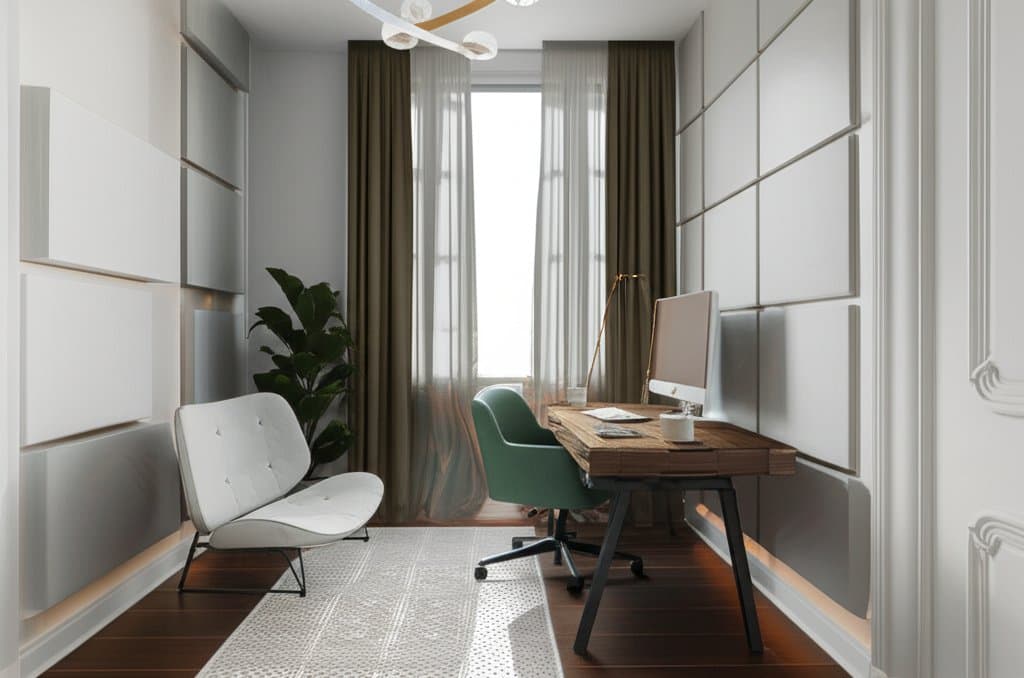- Simple DIY tasks often take a few hours to a full weekend.
- Professional installations for complex systems may span several days.
Skill level:
- Basic DIY solutions: Easy for most homeowners.
- Acoustic panel setups and insulation work: Moderate, requiring some handiness.
- Structural changes involving drywall or framing: Advanced, often best left to experts.
Should You DIY or Hire a Professional?
Certain soundproofing tasks suit beginners, while others demand specialized skills or tools for safety and effectiveness.
Ideal for DIY:
- Attaching door sweeps and weatherstripping to block drafts.
- Hanging heavy acoustic curtains or laying sound-absorbing rugs.
- Applying self-adhesive soundproofing panels to walls.
- Sealing minor gaps with acoustic caulk for a tighter barrier.
Better for professionals:
- Installing additional drywall layers with sound-dampening compounds.
- Setting up resilient channels or decoupling systems to minimize vibration.
- Adjusting HVAC ducts to reduce noise transmission.
- Handling electrical tasks near outlets or lighting fixtures.
Cost differences:
- DIY materials typically range from $50 to $800.
- Professional services can cost between $1,000 and $5,000, based on project complexity.
Step-by-Step Guide to Soundproofing Your Office
1. Identify and Seal Openings
Examine your room for light leaks, drafts, or gaps around doors, windows, and electrical outlets. Apply acoustic caulk to small cracks and install weatherstripping for a snug fit. After sealing, test by feeling for air movement; there should be none.
2. Reinforce Doors
Swap hollow-core doors for solid-core options to block sound better, and attach a door sweep to seal the bottom gap. A properly upgraded door will feel heavier when closed and noticeably reduce incoming noise.
3. Enhance Window Barriers
Hang thick acoustic curtains to dampen outdoor sounds, and consider window inserts or double-pane glass for persistent noise. With curtains drawn, traffic or yard disturbances should sound significantly muted.
4. Soften Hard Surfaces
Lay down rugs or carpets and opt for upholstered furniture to absorb sound waves. Test the room by clapping your hands; echoes should diminish as soft materials increase.
5. Mount Acoustic Panels
Position foam or fabric-wrapped panels on walls where sound bounces most, such as near your desk or opposite noise sources. After installation, internal sounds should feel less harsh during conversations.
6. Strengthen Wall Insulation
For deeper sound control, add a second drywall layer with a damping compound, or use resilient channels to isolate vibrations. Post-installation, external noises like voices or television audio should be far less intrusive.
7. Tackle Ceilings and Floors
Use acoustic ceiling tiles to address noise from above, and add rugs or underlayment to muffle floor sounds. Footsteps or upstairs activity should become much quieter with these adjustments.
Safety Precautions During Installation
Soundproofing involves risks if not approached carefully. Always turn off power to any circuit near outlets or drywall work to avoid electrical hazards. Use a sturdy ladder for high tasks like ceiling treatments to prevent falls, and wear gloves and eye protection when cutting materials or handling insulation. Ensure proper ventilation when using adhesives or caulk to avoid inhaling fumes.
Troubleshooting Persistent Noise Issues
If noise still seeps through walls, determine if it is low-frequency, such as bass, which often requires mass-loaded vinyl or extra drywall for control. For lingering echoes inside, incorporate more soft surfaces like additional curtains or panels. If HVAC vents are the culprit, consider vent baffles or acoustic duct liners. Test improvements by closing all openings and playing audio outside; sounds should be noticeably subdued.
Keeping Your Space Quiet Over Time
Maintain your soundproofing by inspecting door sweeps and weatherstripping annually, replacing them if gaps form. Regularly vacuum acoustic panels and wash curtains to preserve their effectiveness. Structural upgrades like drywall typically endure for the home’s lifespan with minimal care, ensuring long-term peace.
Knowing When to Bring in Experts
For structural alterations, electrical adjustments, or tailored acoustic designs, a licensed contractor becomes essential. Expect consultation or minor installation fees from $300 to $800, while comprehensive wall and ceiling projects may range from $2,000 to $5,000. When selecting a contractor, confirm their licensing and insurance, review past similar work, request detailed estimates, and ensure warranties are included.
Maximizing Your Soundproofing Results
Start with the most vulnerable areas, such as doors and windows, before committing to extensive wall projects for the best initial impact. Layer multiple techniques, combining seals, soft furnishings, and paneling, to achieve substantial noise reduction. After each improvement, assess the difference in sound levels to gauge whether further investment is necessary. Balance your budget with the degree of disruption noise causes, as many find that affordable fixes deliver sufficient calm without major overhauls. With strategic effort, your home office can become a sanctuary of focus and productivity for years ahead.






